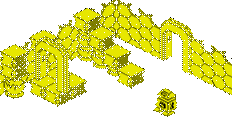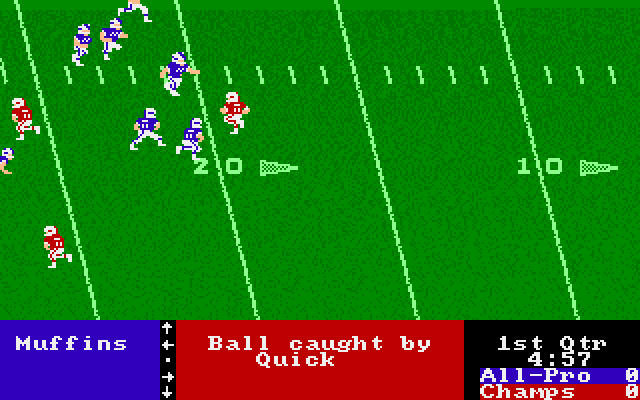4th and Inches (1988) 
| Details (Commodore Amiga) | Supported platforms | Artwork and Media | |
|---|---|---|---|
| Publisher: Genre: Author(s): Minimum Memory Required: Maximum Players: Joysticks: Language: Media Code: Media Type: Country of Release: Related Titles: Other Files: Comments: |  Accolade Inc Accolade IncSport Ed Bogas, Craig Conder, Joe Hitchens, Brian Judd, Les Pardew 512K Yes Eng 3.5" Floppy disk Worldwide 4th and Inches: Team Construction Disk Game Manual Also found on Accolade in Action compilation. | Click to choose platform: Apple 2e Commodore 64 Commodore Amiga |
| Videos | Screenshots (Commodore Amiga) |
|---|---|
| (no videos on file) |
Please login to submit a screenshot
| Your Reviews |
|---|
 Gamespot (Unknown) 23rd Nov 2010 02:30
Gamespot (Unknown) 23rd Nov 2010 02:30A good indicator of how far football game development had come arrived in 1987 with the release of Accolade\'s 4th and Inches for the Commodore 64. The game took football to a new level, combining the traditional arcade action seen in earlier titles with added elements of strategy. For the first time, a football game was compulsively playable as both a simple twitch joystick experience and as a strategic challenge.
4th and Inches was designed by Bob Whitehead as a companion piece to his earlier take on baseball, Hardball, which was published in 1985. Like Hardball, games were played with red teams and blue teams, which were given the generic names of Champs and All-Pros, respectively (actually, this represented a minor change from the baseball title, as the blue team there was called the All-Stars). A full 11-man squad hit the field for each and every play. There were no substitutions, but each player was given different skills and capabilities. Each club also had a distinct personality. The red Champs were physically stronger, possessing a powerhouse ground game, while the blue All-Pros were quicker and better with the passing game. You had to play to these strengths and weaknesses to have a shot at winning in 4th and Inches.
You could choose from a number of plays.
Playcalling clearly foreshadowed what was to come in subsequent football games. You started by designating a formation and then moved on to select an actual play. There were five choices of each every time you entered the huddle, with what you chose as a formation determining what popped up as options for the play itself. These plays were extremely varied on offense, encompassing draws, curls, sweeps, long bombs, and so on. Defense was a little more simplistic, although you still could tailor your formation and assignment for what you thought your opponent was about to attempt. The only real weakness was having to select a running back, receiver, or defensive player to control before the play began and then not being able to switch control during the action. This occasionally left you watching from the wrong side of the field on defense and having to eat the ball rather than throw into tight enemy coverage.
Visuals were understandably crude. The basic act of depicting 11 players on the field sucked up just about all of the resources that the Commodore 64 could call on, so models were little more than stick figures with jittery arms and legs. Even though 4th and Inches came out two years after Hardball, it looked as if it had been designed two years before. It reused many of the sound effects found in its companion game, though, including the national anthem, a white noise crowd effect, and a \"Charge!\" tune that played every time a team moved into scoring range.
Oddly enough, 4th and Inches never evolved past its beginnings. Unlike Hardball, which became Accolade\'s flagship series and lasted through six iterations until the end of the 1990s, this game slowly dropped beneath the radar screens. Its fate might have been better if not for the prompt arrival of even better games, such as TV Sports Football and John Madden Football, which pointed more toward the future than the past. 4th and Inches represented a peak of 1970s and 1980s football game design--a worthy achievement, to be sure, but not one that placed in it a good position to prosper as computers became ever more advanced. Accolade itself was bought out by Infogrames in 1999, and the label was quietly retired.
4th and Inches was designed by Bob Whitehead as a companion piece to his earlier take on baseball, Hardball, which was published in 1985. Like Hardball, games were played with red teams and blue teams, which were given the generic names of Champs and All-Pros, respectively (actually, this represented a minor change from the baseball title, as the blue team there was called the All-Stars). A full 11-man squad hit the field for each and every play. There were no substitutions, but each player was given different skills and capabilities. Each club also had a distinct personality. The red Champs were physically stronger, possessing a powerhouse ground game, while the blue All-Pros were quicker and better with the passing game. You had to play to these strengths and weaknesses to have a shot at winning in 4th and Inches.
You could choose from a number of plays.
Playcalling clearly foreshadowed what was to come in subsequent football games. You started by designating a formation and then moved on to select an actual play. There were five choices of each every time you entered the huddle, with what you chose as a formation determining what popped up as options for the play itself. These plays were extremely varied on offense, encompassing draws, curls, sweeps, long bombs, and so on. Defense was a little more simplistic, although you still could tailor your formation and assignment for what you thought your opponent was about to attempt. The only real weakness was having to select a running back, receiver, or defensive player to control before the play began and then not being able to switch control during the action. This occasionally left you watching from the wrong side of the field on defense and having to eat the ball rather than throw into tight enemy coverage.
Visuals were understandably crude. The basic act of depicting 11 players on the field sucked up just about all of the resources that the Commodore 64 could call on, so models were little more than stick figures with jittery arms and legs. Even though 4th and Inches came out two years after Hardball, it looked as if it had been designed two years before. It reused many of the sound effects found in its companion game, though, including the national anthem, a white noise crowd effect, and a \"Charge!\" tune that played every time a team moved into scoring range.
Oddly enough, 4th and Inches never evolved past its beginnings. Unlike Hardball, which became Accolade\'s flagship series and lasted through six iterations until the end of the 1990s, this game slowly dropped beneath the radar screens. Its fate might have been better if not for the prompt arrival of even better games, such as TV Sports Football and John Madden Football, which pointed more toward the future than the past. 4th and Inches represented a peak of 1970s and 1980s football game design--a worthy achievement, to be sure, but not one that placed in it a good position to prosper as computers became ever more advanced. Accolade itself was bought out by Infogrames in 1999, and the label was quietly retired.
| Cheats | Trivia |
|---|---|
| There are no cheats on file for this title. | No trivia on file for this title. |
History
This title was first added on 19th November 2010
This title was most recently updated on 23rd November 2010






